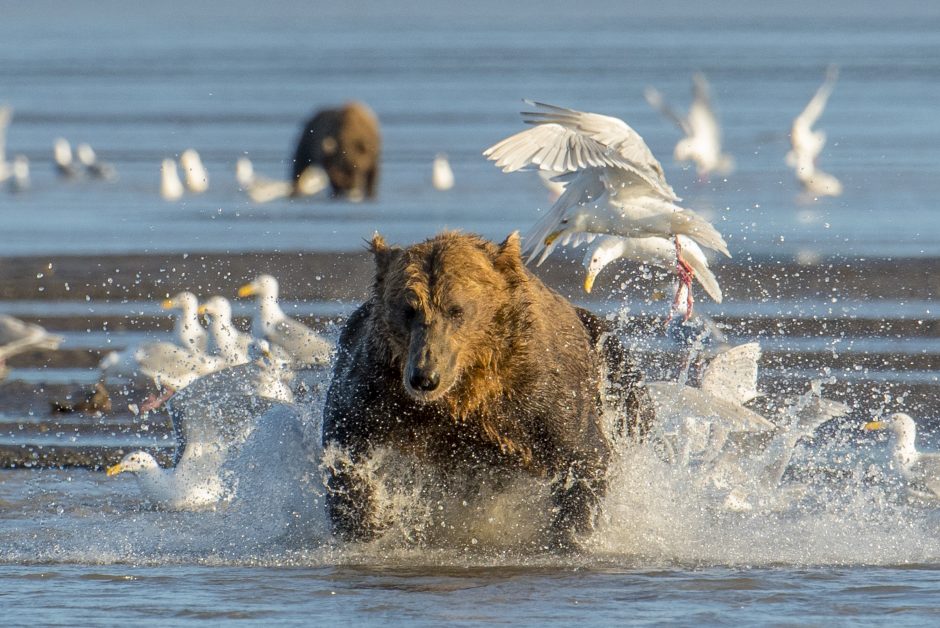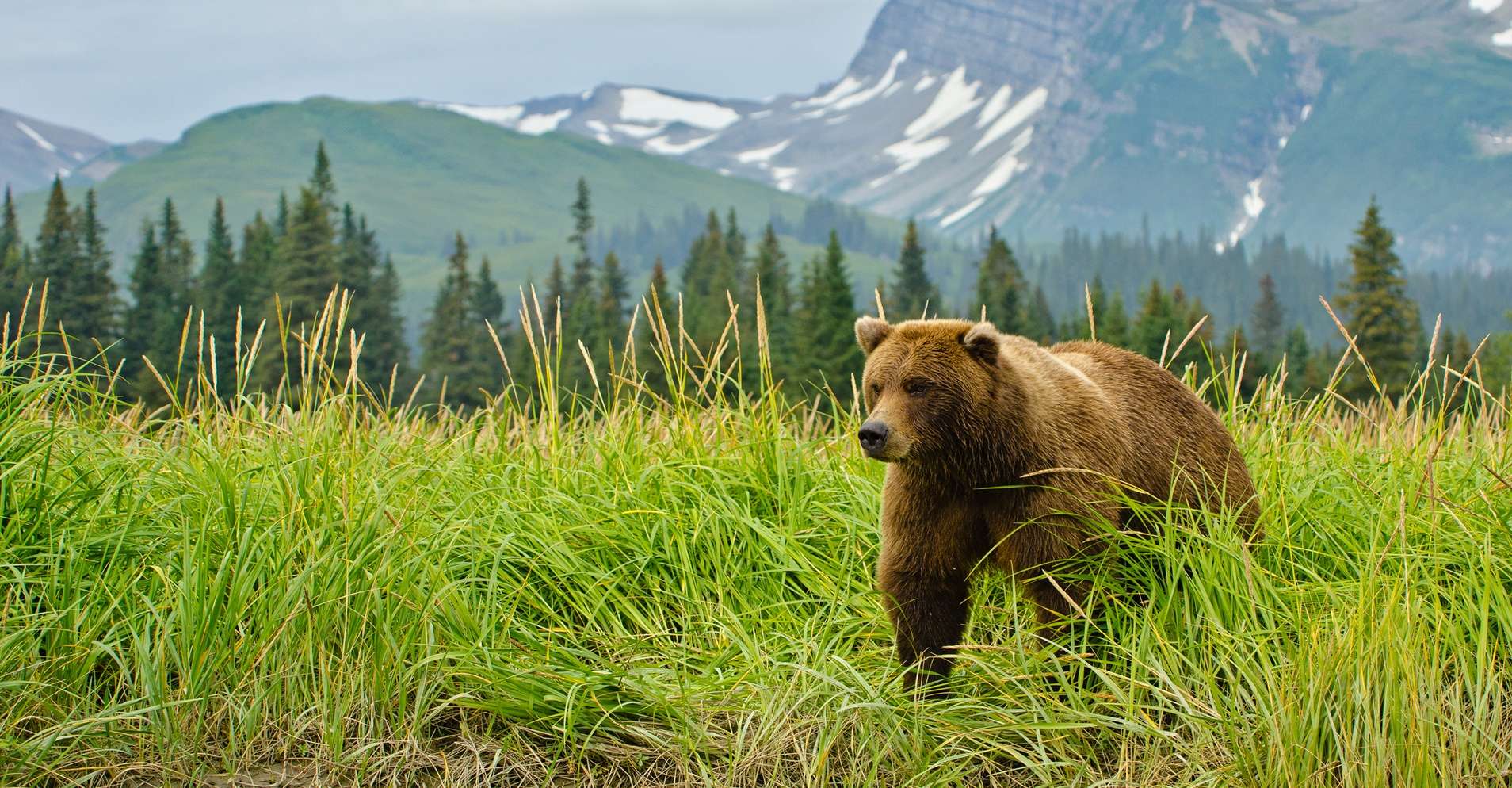
How to pack light for Alaska Bear Adventures
It’s a common dilemma among photographers: hauling your gear to the extremes of the wilderness, while abiding by luggage specifications and weight allowances, all while protecting your camera gear and bringing along your choice equipment.
Limitations vary from place to place, whether you’re on a safari in Africa, trekking in Borneo or cavorting with Grizzlies in Alaska. But the latter often seems to be the most stringent due to the small bush planes necessary to land on gravel beds, beaches, small runways and oftentimes on the water itself.
In this article, I’m going to go with some of the lowest weight allowances out there, specifically as it pertains to Nat Hab’s new Bear Camp adventure, so that you can see how I personally choose my camera gear for such an expedition.

The weight allowances for luggage come in at 20 pounds for this Alaska Bear Camp expedition. So, the first thing I’m going to do is see how much of this 20 pounds needs to be made up of clothes—and how much can be pure photography gear.
For this trip to Alaska’s Bear Camp near Lake Clark National Park, we’re looking at three nights in the field, which means minimal clothing. At absolute most, I’m going to bring two sets of field clothes and one set of lounging/comfy clothes for camp in the evening. The rest I would recommend leaving in Homer with Nat Hab’s operations staff to collect when you return. Things that make it in this smaller “leave behind bag” would be airplane clothes, any extra books for travel days, etc.
In weighing these clothes, plus a pound or two for basic toiletries, I come in at five pounds, which mean I’m able to devote 15 pounds to my camera gear. This isn’t a lot, but it’s also a pretty good chunk I can make use of.
Here is my “critical kit” that I wouldn’t do any wildlife adventure without:
Canon 5d IV – 2 pounds
Canon 100-400mm – 3.5 pounds
Canon 24-105mm – 1.5 pounds
Extra batteries and charger – 0.5 pounds
7.5 pounds total
I don’t leave home without all this, and we’re coming in at about eight pounds. That’s encouraging! So, I technically have nearly eight more pounds to play with.

If we get into the super telephotos, this weight gets eaten up pretty quickly. Adding a 500mm to the kit would be just about the rest of the weight. However, if you have it, it’s a wise way to use the extra weight!
However, one could make the argument that adding a 500mm might shift the balance of your kit anyways, perhaps replacing the 100-400. But as you may be thinking, it’s never that straightforward. It really comes down to personal preference and photographic style.
The other class of lens that’s missing from my above critical kit is the 70-200mm. This is indeed a great lens, and with its f/2.8 capabilities, it adds a very valuable tool to your kit. This lens comes in at about 3.5 pounds, so it would put us at 13 pounds out of 15.
Another piece of gear that you may be considering is another camera body. These can be quite handy, as they allow you to easily shoot with two different lenses, which can ultimately yield more shots of those extra special encounters. While not absolutely necessary, many pro photographers do like to bring a second body. For many others, though, a smartphone is a great second camera. With your main telephoto mounted on your camera, you have a fantastic landscape camera and lens at the ready via your smartphone. It’s getting downright incredible what they are able to capture!
So, if you bring a second body at two pounds, that puts you right at about 15 pounds, even with the 70-200mm.
You may be wondering, what about a tripod or monopod? This is where it gets tricky. Even the most lightweight tripods out there will run you about 3-4 pounds. Thus, you are putting a heavy premium on its use. If you are a tripod fanatic, then it might replace your second telephoto lens (e.g., if you are considering both a 100-400 and 70-200, or a 100-400 and 500mm).
However, if you are not a tripod fanatic, oftentimes a monopod may be an even better option, especially as they can weigh a pound or less. They don’t have the multi-leg support of a tripod, but they help to steady your camera as you sit and observe wildlife—and they take a load off your neck and shoulders!

A big question on all bush flights is “What can I physically wear on me while I weigh in for the flight?”
That’s a great question, and it varies considerably across planes, states, countries and even pilots. Technically, they reserve the right to make you remove your camera before weighing. However, a great way to save a little pack weight is to throw some small camera gear in your pockets, such as your smartphone, extra batteries, etc. Additionally, since bush flights may be cold, it behooves you to wear an extra layer, like a jacket or windbreaker, and your hiking boots, which further saves weight from your pack.
At the end of the day, for remote wilderness adventures and wildlife photography, there are always some sacrifices. That sacrifice could be choosing a tripod vs. an extra lens, or focusing primarily on wildlife camera gear vs. landscape gear, or doing what I do and bringing very minimal extra clothes. (Field clothes get dirty almost immediately, so why not just re-wear them?) Of course, these are all small concessions for being shuttled into the great beyond and spending time with some of the grandest nature and wildlife on the planet.
If you have extra tips you’ve learned over the years, please share them in the comments below!
Best,

Court
10 Comments

Mono Grencel
April 22, 2022 at 10:51 am

Court Whelan, Ph.D.
April 25, 2022 at 2:40 pm

Chris Higgs
July 2, 2022 at 2:32 pm

Court Whelan, Ph.D.
July 10, 2022 at 9:31 am

JamesJeffries
September 29, 2022 at 12:21 pm

Court Whelan, Ph.D.
October 4, 2022 at 7:12 am

Jack k.
November 29, 2022 at 11:25 pm

Court Whelan, Ph.D.
December 12, 2022 at 11:16 am

eiko.hariu
July 23, 2023 at 8:41 pm

Court Whelan, Ph.D.
July 28, 2023 at 9:59 am
Hi
Thanks for the advises.
How do you pack the camera and lenses ? If i take my bag, it is quit heavy
Mono Grencel
hi Mono, camera bags come in so, so many shapes and sizes. When I’m trying to save space and weight, I usually pack my camera and lenses inside my backpack, wrapped around clothing for protection. A camera bag is nice, but they’re usually quite bulky and heavy for protection. In this case you’ll need to be a little more careful when transporting your bag, but it can easily save you 5+ pounds this way.
If weight is not an issue, do you recommend a 16-35 wide for Bear camp or is 24-105 wide enough. Shooting with Canon R5. Also Taking 70-200 2.8 and 150-600 on 7D II
hi Chris! Personally I think a 24-105 is fine. There are really very very few times (maybe none) that you’d use the 16-35, and the extra 35-105mm range is fantastic for framing your shots. That’s the way I’d go :). Good additional lenses/bodies, too!
Hi Court
One thing you don’t mention is Binocs. These are essential on safari and I would think pretty useful on an Alaskan bear trip.
They tend to be pretty weighty especially if you go for Canon 18×50 which I love for African safaris.
hi James! Very good point. To me, it’s usually an either-or. Frankly, a good telephoto zoom gets you to the about the same distance as good binoculars, and then you not only get to see the animal, but then you get a great shot, too :). If you have the weight and room to bring binocs, they are wonderful. But, I’ve found over the years that ardent photographers usually tend to stick to their cameras as their optics piece to zoom in and view animals. Plus, many Alaska adventures actually have binoculars for use (at least many of those with Natural Habitat Adventures do), saving a bit of weight from your packing list :).
I’m going to Bear Camp in June and am already trying to figure out what camera gear to bring vs. leave home. I’m thinking 2 bodies, R6&R7, my 100-500 and
24-105. If weight permits I’ll add a monopod.
Hi Jack, this is a perfect setup! We do have ample tripods up there, so if you can’t fit the monopod I think it’s ok. However, if you have space and room I think that’d be great! Plus, if you walk onto the airplane with the monopod like a walking stick, maybe it won’t be weighed ;).
Hope this helps!
Hello Court, thank you for your time to read this..Appreciate your input. I am going to the Bear camp in mid Aug. Total 20 lb (05 lb on your lap and 15 lb check in) is a bit challenge when I want to bring 2 body. For the bear camp – which lens did you use the most? 100-400mm? I am thinking of brining 200-600mm, 70-200mm and 2.0 teleconverter. If weight permits – I would like to bring 24-75mm. I have no problem carrying my equipments and walking around. Of course, I prefer to place them in the my trusted? camera bag, but it will eat my weight. So thinking of place them in my dry bag and protect them with my clothes – making it 15 lb check in bag. I trust sea plane site- Nat Hab team will not toss our luggage and handle them very careful? I can hand carry and explain what is inside my dry bag. Would that works? Thank yo so much for your input. Regards, Eiko
hi Eiko! So great to hear that you’ll be joining us at Bear Camp! To your point, yes, the 200-600 will be one of your most useful lenses, and then I’d say your 24-75 would be a close second. However, I love, love, love the 70-200 class of lens, too–I just don’t think you’d need the teleconverter with it. That’s probably the smallest, lightest piece of gear, but I just don’t think it’s worth it, as you’ll want the 200-600 for anything you need real power for.
As far as how to get to the weight, a dry bag would be just fine. Everyone takes great care of gear–just make sure it’s padded well enough so that if it is in the back of the plane, small bumps from flying won’t ruin anything. You can also put a lens in your pocket if needed :). The pilots always reserve the right to stick to a strict 20 pounds, but if you have, say, 22 pounds I think you’ll be fine :). I hope this helps! Let me know if I can help further.